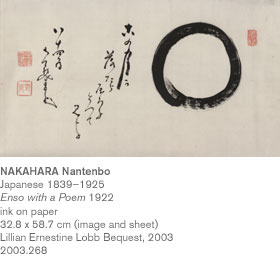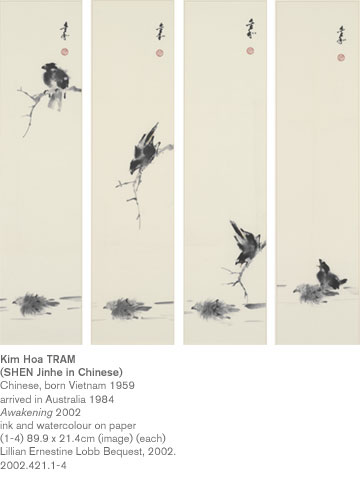The art of Zen education resource
Zen: A living tradition
 Zen Buddhism continues as a living tradition in Japan, South Korea, and Vietnam and also in some countries in the West including Australia.
Zen Buddhism continues as a living tradition in Japan, South Korea, and Vietnam and also in some countries in the West including Australia.
Nantenbo (1839-1925) was a Japanese Zen monk of the Rinzai sect. A disciplined Zen teacher and prolific Zen painter, Nantenbo learned to use painting and calligraphy as means of expressing the Zen spirit that lies beyond words. He created most of his paintings and calligraphy when he was in his late seventies and early eighties. In the painting Enso with a poem , the enso (circle) accomplished in one continuous brushstroke is accompanied by a poem written in cursive calligraphy and translated 'If that moon falls, I will give it to you. Now try to take it'.
The enso ('circle') is one of the deepest symbols in Japanese Zen. The enso is the revelation of a world of the spirit without beginning and end. The Zen circle of enlightenment reflects that transforming experience - perfectly empty yet completely full, infinite, shining brightly like the moon-mind of enlightenment.
The Awakening is a highly powerful and original work by Kim Hoa Tram (Shen jinhe in Chinese), who was born in Saigon, Vietnam in 1959, to a family originally from Fujian province in China. He came to Australia in 1984. For more than ten years, Kim has immersed himself in Zen Buddhism. The Awakening deals with the Buddhist concept of spiritual awakening to the impermanence of life, and death itself. A living bird and a dead bird are repeated in a sequence as the narrative unfolds in four panels that are read from right to left. It progresses upward in crescendo from a baby bird crying helplessly beside a dead bird; a young bird shouting or screaming in shock; an older bird staring at the dead bird, as if coming to some kind of realization. Finally in the last panel, the wise old bird is perched on a branch near the top of the painting, with an enigmatic expression of acceptance.

The silence that is conveyed by the void in the fourth panel is as emotionally intense as the scream in the second panel. The bird has been used as a vehicle to express human emotions in the confrontation of 'death'. The images express what is beyond words.